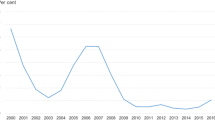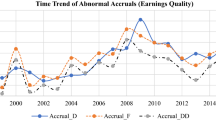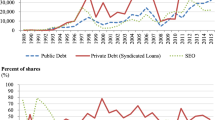Abstract
Loan tranching allows banks to manage risk and facilitate firm financing, which may be essential for firms that cannot access investors from stock markets. We analyze the determinants and benefits of loan tranching by pooling the tranches of individual loans to create the largest cross-country sample of syndicated loans, covering more than 150,000 loans from multinational and domestic firms. We find that, in addition to market, deal, and borrower characteristics, legal and institutional differences impact loan tranching. Strong creditor protection and efficient debt collection increase the probability of tranching and reduce tranche spreads, ultimately promoting firms’ access to debt. We also find evidence that tranching facilitates the financing of multinational firms abroad due to the transfer of legal and cultural institutions to foreign subsidiaries. Overall, our results suggest that tranching plays an important role in reducing a country’s financial development gap and promotes firms’ access to debt.
Abstraite
Le découpage en tranches de prêts permet aux banques de gérer les risques et de faciliter le financement des firmes, ce qui peut être essentiel pour les firmes qui ne peuvent pas accéder aux investisseurs des marchés boursiers. Couvrant plus de 150 000 prêts d’entreprises multinationales et nationales, nous analysons les déterminants et les avantages du découpage en tranches de prêts en regroupant les tranches de prêts individuels afin de créer le plus grand échantillon transnational de prêts syndiqués. Nous constatons que, outre les caractéristiques du marché, des transactions et de l’emprunteur, des différences juridiques et institutionnelles influencent l’établissement des tranches de prêts. Une solide protection des créanciers et un recouvrement efficace de la dette augmentent les probabilités de découpage en tranches et réduisent les écarts de tranche, favorisant ainsi l’accès des entreprises à la dette. Nous trouvons également des preuves que les tranches facilitent le financement de firmes multinationales à l’étranger en raison du transfert d’institutions juridiques et culturelles à des filiales étrangères. Globalement, nos résultats suggèrent que les tranches jouent un rôle important dans la réduction de l’écart de développement financier d’un pays et favorisent l’accès des firmes à la dette.
Abstracto
La partición en tramos de préstamos permite a los bancos manejar riesgos y facilitar el financiamiento de empresas, lo cual puede ser esencial para empresas que no pueden acceder inversionistas en los mercados de capitales. Analizamos los determinantes y beneficios de partir los préstamos en tramos, al juntar los préstamos individuales particionados para crear la mayor muestra entre países de préstamos sindicados, cubriendo más de 150.000 préstamos de multinacionales y empresas nacionales. Encontramos que, además de las características del mercado, las operaciones y los prestamistas, las diferencias legales e institucionales impactan la partición en tramos de los préstamos. La fuerte protección a los acreedores y el cobro eficiente de deudas aumentan la probabilidad de partir los préstamos y reducen las diferencias en tasas o spreads, promoviendo a la larga el acceso a financiación de las empresas. Encontramos también evidencia de que la partición de los préstamos facilita el acceso a financiación de empresas multinacionales en el extranjero debido a la transferencia de instituciones legales y culturales de apoyo a las filiales extranjeras. En general, nuestros resultados sugieren que la partición de los préstamos en tramos juegan un papel importante en reducir la brecha de desarrollo financiero de un país y promueven el acceso a deuda.
Abstrato
O empréstimo em faixas de risco permite que os bancos gerenciem os riscos e facilitem o financiamento de empresas, o que pode ser essencial para as empresas que não podem acessar investidores do mercado de ações. Analisamos os determinantes e os benefícios do empréstimo em faixas agrupando faixas de empréstimos individuais para criar a maior amostra de empréstimos sindicalizados entre países, cobrindo mais de 150.000 empréstimos de empresas multinacionais e domésticas. Descobrimos que, além das características de mercado, do negócio e do mutuário, diferenças legais e institucionais afetam as faixas do empréstimo. Forte proteção ao credor e a cobrança eficiente da dívida aumentam a probabilidade de criação de faixas e reduzem o spread das faixas, promovendo, em última análise, o acesso de empresas ao financiamento. Também encontramos evidências de que faixas facilitam o financiamento de empresas multinacionais no exterior devido à transferência de instituições legais e culturais para subsidiárias estrangeiras. De modo geral, nossos resultados sugerem que faixas desempenham um papel importante na redução do hiato no desenvolvimento financeiro de um país e promove o acesso de empresas a financiamento.
摘要
贷款风险分级允许银行管理风险并促进公司融资, 这对于无法从股票市场获得投资者的公司而言可能是必不可少的。我们通过汇集单笔贷款证券来分析贷款风险分级的决定因素和收益, 以创建最大的跨国银团贷款样本, 涵盖来自跨国公司和国内公司的150,000多笔贷款。我们发现, 除市场、交易和借款人特征外, 法律和制度差异也影响贷款风险分级。强有力的债权人保护和有效收债提高风险分级的可能性并减少证券差价, 最终促进公司获得债务的机会。我们还发现了由于法律和文化制度向外国子公司的转移, 风险分级促进海外跨国公司融资的证据。总的来说, 我们的结果表明,风险分级在减少一个国家的金融发展差距和促进公司获得债务方面起着重要作用。

Similar content being viewed by others
REFERENCES
Aggarwal, R., & Kyaw, N. 2008. International capital networks as a source of MNC competitive advantage: Evidence from foreign subsidiary capital structure decisions. Research in International Business and Finance, 22(3): 409–439.
Aguilera, R. V., Desender, K., Lopez-Puertas Lamy, M., & Lee, J. H. 2017. The governance impact of a changing investor landscape: Foreign investors and managerial earnings forecasts. Journal of International Business Studies, 48(2): 195–221.
Allen, F., Carletti, E., Cull, R., Qian, J., Senbet, L. W., & Valenzuela, P. 2012. Resolving the African financial development gap. In S. Edwards, S. Johnson, & D. Weil (Eds.), NBER volume on African development successes. Chicago: University of Chicago Press.
Allen, F., Carletti, E., Cull, R., Qian, J., Senbet, L. W., & Valenzuela, P. 2014. The African financial development and financial inclusion gaps. Journal of African Economies, 23(5): 614–642.
Allen, F., Otchere, I., & Senbet, L. W. 2011. African financial systems: A review. Review of Development Finance, 1(2): 79–113.
Bae, K.-H., & Goyal, V. K. 2009. Creditor rights, enforcement and bank loans. Journal of Finance, 84: 823–860.
Banerjee, S., & Noe, T. 2017. Legal system arbitrage and parent-subsidiary capital structures, working paper. Management Science, 63(11): 3809–3822.
Beck, T., Demirgüç-Kunt, A., & Levine, R. 2010. Financial institutions and markets across countries and over time: The updated financial development and structure database. The World Bank Economic Review, 24: 77–92.
Beck, T., & Levine, R. 2005. Legal institutions and financial development. In C. Menard & M. M. Shirley (Eds.), Handbook of new institutional economics (pp. 251–278). U.S.A.: Springer.
Beck, T., Senbet, L. W., & Simbanegavi, W. 2014. Financial inclusion and innovation in Africa: An overview. Journal of African Economies, 24(1): i3–i11.
Bergman, N. K., & Nicolaievsky, D. 2007. Investor protection and the Coasian view. Journal of Financial Economics, 84: 738–771.
Beugelsdijk, S., Kostova, T., & Roth, K. 2017. The Impact of Kirkman, Lowe and Gibson’s article on country-level research in international business. Journal of International Business Studies, 48(1): 30–47.
Boot, A. W. A., & Thakor, A. V. 1993. Security design. Journal of Finance, 48: 1349–1378.
Boulton, T., Smart, S., & Zutter, C. 2017. Conservatism and international IPO underpricing. Journal of International Business Studies, 48(6): 763–785.
Brennan, M. J., Hein, J., & Poon, S.-H. 2009. Tranching and rating. European Financial Management, 15(5): 891–922.
Breuer, W., Riesener, M., & Salzmann, A. J. 2012. Risk aversion vs. individualism: What drivers risk taking in household finance? European Journal of Finance, 20(5): 446–462.
Bris, A., & Cabolis, C. 2008. The value of investor protection: Firm evidence from cross-border mergers. Review of Financial Studies, 21(2): 605–648.
Chong, A., La Porta, R., Lopez-de-Silanes, F., & Shleifer, A. 2014. Letter grading government efficiency. Journal of the European Economic Association, 12(2): 277–299.
Chowdhry, B., & Coval, J. 1998. International financing of multinational subsidiaries: Debt vs. equity. Journal of Corporate Finance, 4(1): 87–106.
Coase, R. 1960. The problem of social cost. Journal of Law and Economics, 3: 1–44.
Cumming, D. J., Filatoctchev, I., Knill, A., Reeb, D., & Senbet, L. 2017. Law, finance, and the international mobility of corporate governance. Journal of International Business Studies, 48(2): 123–147.
Dennis, S. A., & Mullineaux, D. J. 2000. Syndicated loans. Journal of Financial Intermediation, 9: 404–426.
Desai, M. A., Foley, C. F., & Hines, J. R. 2004. A multinational perspective on capital structure choice and internal capital markets. Journal of Financial Studies, 59(6): 2451–2487.
Djankov, S., La Porta, R., Lopez-de-Silanes, F., & Shleifer, A. 2003. Courts. Quarterly Journal of Economics, 118(2): 453–517.
Djankov, S., McLiesh, C., & Shleifer, A. 2007. Private credit in 129 countries. Journal of Financial Economics, 84: 299–329.
Eden, L., & Miller, S. R. 2004. Distance matters: Liability of foreignness, institutional distance and ownership strategy. In M. A. Hitt & J. L. C. Cheng (Eds.), Theories of the multinational enterprise: Diversity, complexity and relevance (pp. 187–221). Bingley, UK: Emerald Group Publishing Limited.
Ellis, J. A., Moeller, S. B., Schlingemann, F. P., & Stulz, R. M. 2017. Portable country governance and cross-border acquisitions. Journal of International Business Studies, 48(2): 148–173.
Esty, B. C., & Megginson, W. L. 2003. Creditor rights, enforcement, and debt ownership structure: Evidence from the global syndicated loan market. Journal of Financial and Quantitative Analysis, 38(1): 37–59.
Gande, A., John, K., & Senbet, L. 2008. Bank incentives, economic specialization, and financial crises in emerging economies. Journal of International Money and Finance, 27(5): 707–732.
Giambona, E., Lopez-de-Silanes, F., & Matta, R. 2018. Stiffing the creditor; The effect of asset verifiability on bankruptcy, SSRN working paper: https://ssrn.com/abstract=2912366.
Giannetti, M., & Yafef, Y. 2012. Do cultural differences between contracting parties matter?: Evidence from syndicated bank loans. Management Science, 58(2): 365–383.
Harjoto, M., Mullineaux, D. J., & Yi, H.-C. 2006. A comparison of syndicated loan pricing at investment and commercial banks. Financial Management, 35(4): 49–70.
Hope, O., Thomas, W., & Vyas., D. 2011. Financial credibility, ownership, and financing constraints in private firms. Journal of International Business Studies, 42(7): 935–957.
Huang, T., Wu, F., Yu, J., & Zhang, B. 2019. Investor protection and the value of impact of stock liquidity. Journal of International Business Studies. https://doi.org/10.1057/s41267-019-00228-6.
Johan, S. A., Knill, A., & Mauck, N. 2013. Determinants of sovereign wealth fund investment in private equity vs public equity. Journal of International Business Studies, 44(2): 155–172.
John, K., Saunders, A., & Senbet, L. W. 2000. A theory of bank regulation and management compensation. Review of Financial Studies, 13(1): 95–125.
John, K., & Senbet, L. W. 1998. Corporate governance and board effectiveness. Journal of Banking & Finance, 22(4): 371–403.
John, K., Senbet, L. W., & Sundaram, A. K. 1991. Cross-border liability of multinational enterprises, border taxes and capital structure. Financial Management, 20(4): 54–67.
Kirkman, B. L., Lowe, K. B., & Gibson, C. B. 2006. A quarter century of culture’s consequences: A review of empirical research incorporating Hofstede’s cultural values framework. Journal of International Business Studies, 37: 285–320.
Kirkman, B. L., Lowe, K. B., & Gibson, C. B. 2017. A retrospective on culture’s consequences: The 35-year journey. Journal of International Business Studies, 48: 12–29.
La Porta, R., Lopez-de-Silanes, F., Pop-Eleches, C., & Shleifer, A. 2004. Judicial checks and balances. Journal of Political Economy, 112(2): 445–470.
La Porta, R., Lopez-de-Silanes, F., & Shleifer, A. 2006. What works in securities laws? Journal of Finance, 61(1): 1–32.
La Porta, R., Lopez-de-Silanes, F., & Shleifer, A. 2008. The economic consequences of legal origins. Journal of Economic Literature, 46: 285–332.
La Porta, R., Lopez-de-Silanes, F., Shleifer, A., & Vishny, R. W. 1997a. Legal determinants of external finance. Journal of Finance, 52: 1131–1150.
La Porta, R., Lopez-de-Silanes, F., Shleifer, A., & Vishny, R. W. 1997b. Trust in large organizations. American Economic Review, Papers and Proceedings, 87(2): 333–338.
La Porta, R., Lopez-de-Silanes, F., Shleifer, A., & Vishny, R. W. 1998. Law and finance. Journal of Political Economy, 106: 1113–1155.
La Porta, R., Lopez-de-Silanes, F., Shleifer, A., & Vishny, R. W. 1999. The quality of government. Journal of Law, Economics and Organizations, 15: 222–279.
Levine, R., & Zervos, S. 1998. Stock markets, banks, and economic growth. American Economic Review, 88: 537–558.
Mac an Bhaird, C., & Lucey, B. 2014. Culture’s influences: An investigation of inter-country differences in capital structure. Borsa Istanbul Review, 14(1): 1–9.
Maskara, P. K. 2010. Economic value in tranching of syndicated loans. Journal of Banking & Finance, 34: 946–955.
Maskara, P.K., & Mullineaux, D.J. 2006. Loan syndication participation by investment banks and nonbank financial entities. SRN working paper: http://dx.doi.org/10.2139/ssrn.3354840.
Maskara, P. K., & Mullineaux, D. J. 2011a. Information asymmetry and self-selection bias in bank loan announcement studies. Journal of Financial Economics, 101(3): 684–694.
Maskara, P. K., & Mullineaux, D. J. 2011b. Small firm capital structure and the syndicated loan market. Journal of Financial Services Research, 39(1–2): 55–70.
McCahery, J., & Schwienbacher, A. 2010. Bank reputation in the private debt market. Journal of Corporate Finance, 16(4): 498–515.
McDonald, C., Schumacher, L. 2007. Financial deepening in Sub-Saharan Africa: Empirical evidence on the role of creditor rights protection and information sharing. IMF Working Paper; http://www.imf.org/external/pubs/cat/longres.aspx?sk=21195.
Mezias, J. 2002. How to identify liabilities of foreignness and assess their effects on multinational corporations. Journal of International Management, 8(3): 265–282.
Miletkov, M. K., Poulsen, A. B., & Wintoki, M. B. 2017. Foreign independent directors and the quality of legal institutions. Journal of International Business Studies, 48(2): 267–292.
Noe, T.H. 1998. Creditor rights and multinational capital structure, SSRN Working Paper No. 139451. https://papers.ssrn.com/sol3/papers.cfm?abstract_id=139451.
Qi, Y., Roth, L., & Wald, J. 2011. How legal environments affect the use of bond covenants. Journal of International Business Studies, 42(2): 235–262.
Qi, Y., Roth, L., & Wald, J. 2017. Creditor protection laws, debt financing, and corporate investment over the business cycle. Journal of International Business Studies, 48(4): 477–497.
Renneboog, L., Szilagyi, P. G., & Vansteenkiste, C. 2017. Creditor rights, claims enforcement, and bond performance in mergers and acquisitions. Journal of International Business Studies, 48(2): 174–194.
Ronen, S., & Shenkar, O. 2013. Mapping world cultures: Cluster formation, sources and implications. Journal of International Business Studies, 44(9): 867–897.
Ross, S. A. 1979. Disclosure regulation in financial markets: Implications of modern finance theory and signaling theory. In F. Edwards (Ed.), Issues in financial regulation. New York: McGraw Hill.
Senbet, L. W., & Taggart, R. A. 1984. Capital structure equilibrium under market imperfections and incompleteness. Journal of Finance, 39(1): 93–103.
Senbet, L. W., & Wang, T. Y. 2012. Corporate financial distress and bankruptcy: A survey. Foundations and Trends in Finance, 5(4): 243–335.
Taylor, A., & Sansone, A. (Eds.). 2007. The handbook of loan syndications and trading. New York: McGraw-Hill.
Thomson Reuters 2017. Global syndicated loans review—Managing underwriters. Available at https://www.thomsonreuters.co.jp/content/dam/openweb/documents/pdf/japan/market-review/2017/loan-4q-2017-e.pdf.
Acknowledgements
We are indebted to the Editor, Lemma Senbet, an anonymous member of the JIBS editorial board, two anonymous reviewers, Kee-Hong Bae, William Bratton, Sofia Johan, Jeffrey Gordon, Pankaj Maskara, and Luc Renneboog for their very helpful comments and suggestions. We also wish to thank conference participants at the FMA meetings, and seminar participants in Amsterdam, ETZ, HSE-Moscow, Oxford, SKEMA Business School, Louvain, Tilburg, Yonsei, and York for their comments.
Author information
Authors and Affiliations
Corresponding author
Additional information
Publisher's Note
Springer Nature remains neutral with regard to jurisdictional claims in published maps and institutional affiliations.
Supplementary information accompanies this article on the Journal of International Business Studies website (www.palgrave.com/ journals).
Accepted by Lemma Senbet, Area Editor, 12 May 2019. This article has been with the authors for three revisions.
Electronic supplementary material
Below is the link to the electronic supplementary material.
Rights and permissions
About this article
Cite this article
Cumming, D., Lopez-de-Silanes, F., McCahery, J.A. et al. Tranching in the syndicated loan market around the world. J Int Bus Stud 51, 95–120 (2020). https://doi.org/10.1057/s41267-019-00249-1
Received:
Revised:
Accepted:
Published:
Issue Date:
DOI: https://doi.org/10.1057/s41267-019-00249-1




